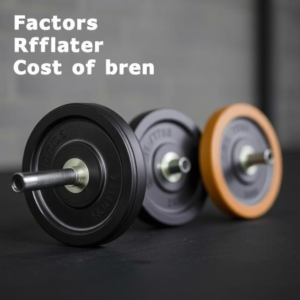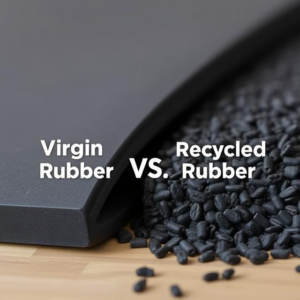Factors Affecting the Cost of Rubber Weight Plates

Introduction
Rubber weight plates are essential for strength training, providing durability, floor protection, and noise reduction. However, their prices vary significantly based on several factors. Understanding these cost determinants helps you make an informed purchase that fits your budget and lifting needs. This guide explores the key factors influencing the cost of rubber weight plates, ensuring you invest wisely in your fitness equipment.
1. Material Quality
The type of rubber used in weight plates directly impacts their price, durability, and performance. There are two main types:
Virgin Rubber vs. Recycled Rubber

- Virgin Rubber: Made from new, high-quality materials, virgin rubber weight plates are highly durable, resistant to wear, and excellent at shock absorption. These premium plates are ideal for heavy lifters and commercial gyms, but they come at a higher cost.
- Recycled Rubber: More affordable than virgin rubber, recycled rubber plates are made from repurposed materials. While they offer decent durability, they are more prone to cracking and may not last as long as virgin rubber plates. Budget-conscious buyers often opt for these plates.
Olympic-Grade Rubber
Olympic weight plates are manufactured using top-quality rubber to withstand rigorous use. They are designed to be dropped without damage, making them a preferred choice for professional weightlifters and high-intensity training environments.
2. Plate Type and Design
The type and design of weight plates play a crucial role in their pricing. Different styles are tailored for specific training needs.
Bumper Plates
- Standard Bumper Plates: Made from dense rubber, these plates absorb impact well, reducing floor damage and noise. Their durability makes them slightly more expensive than traditional cast iron plates.
- Hi-Impact Bumper Plates: Designed for repeated heavy drops, these premium plates use superior materials that resist cracking, increasing their cost.
- Competition Bumper Plates: These plates offer precise weight accuracy, feature steel inserts for added durability, and follow a color-coded system for easy identification. They are thinner than standard bumper plates, allowing more weight to be loaded onto the barbell. Due to their precision engineering, they tend to be more expensive.
3. Weight Range and Increments
The available weight range and increments also influence the price of rubber weight plates.
- Variety of Weights: Plates typically range from 2.5 lbs to 45 lbs (or higher). Having access to a wide weight range provides training flexibility but may increase overall costs.
- Change Plates: These smaller plates allow lifters to make precise weight adjustments. Though lightweight, their precision manufacturing and demand for incremental progression can make them relatively expensive.
- Dual lb/kg Plates: Plates featuring both imperial and metric units provide added convenience for athletes training in different measurement systems, often carrying a higher price tag due to additional design considerations.
4. Brand Reputation
The manufacturer and brand reputation significantly impact cost.
- Premium Brands: Well-established fitness brands charge a premium for their products due to their high manufacturing standards, rigorous testing, and superior materials. They often offer extended warranties, making them a long-term investment.
- Budget Brands: Lesser-known brands provide more affordable options, but they may not maintain the same quality control or longevity as premium brands.
5. Special Features That Affect Cost
Additional features enhance the durability, functionality, and aesthetic appeal of rubber weight plates but can also increase their price.
Thin-Profile Bumper Plates
These plates are designed to take up less space on the barbell while allowing for heavier loads. Their specialized design and high-density rubber construction make them more expensive than standard bumper plates.
Steel Inserts and Reinforcements
Many high-end bumper plates feature steel or brass inserts, improving structural integrity and extending lifespan. This reinforcement process adds to the manufacturing cost.
Protective Coatings
Some rubber plates include polyurethane or other protective layers to resist wear and tear. While this enhances durability, it also raises the overall cost of the plates.
6. Shipping and Additional Costs
Rubber weight plates are heavy, and shipping costs can significantly impact the final price.
- Shipping Fees: Due to their weight, shipping costs can be substantial, especially for bulk orders.
- Bulk Purchase Discounts: Some sellers offer discounts on large orders, making it more cost-effective for commercial gyms or serious lifters.
- Customization Costs: Plates with custom branding, color coding, or logos generally come at a premium price due to additional design and manufacturing efforts.
Conclusion
The cost of rubber weight plates depends on several factors, including material quality, plate type, brand reputation, weight increments, special features, and shipping costs. By understanding these elements, you can make a well-informed decision based on your training needs and budget. Whether you opt for high-end competition bumper plates or cost-effective recycled rubber plates, choosing the right option ensures a great return on investment in your strength training journey.